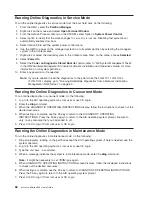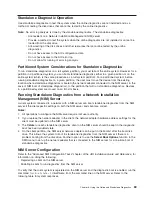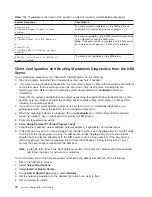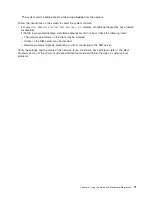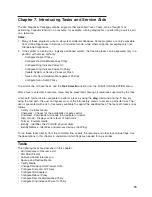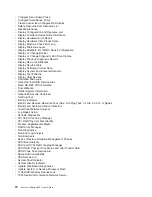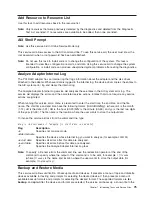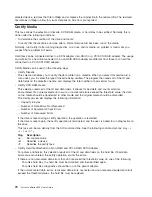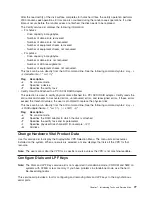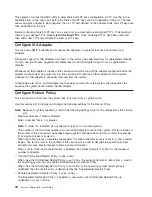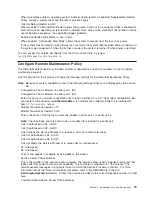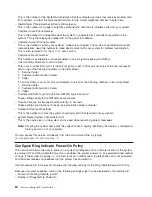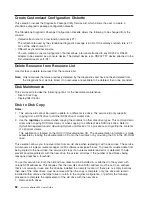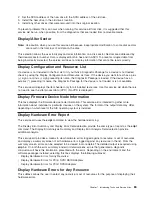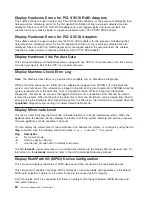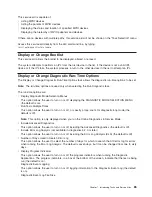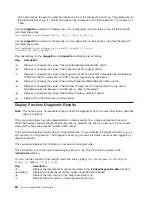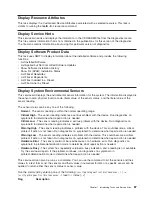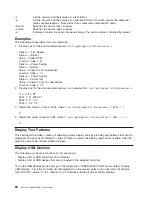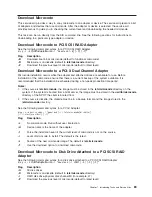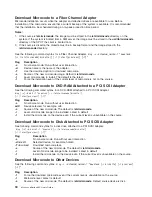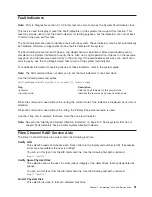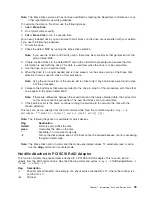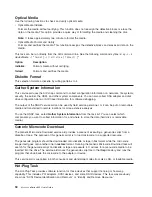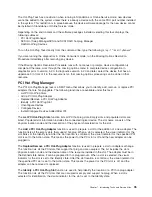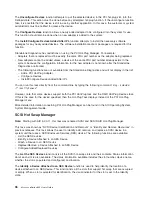
You
can
access
this
service
aid
directly
from
the
AIX
command
line,
by
typing:
/usr/lpp/diagnostics/bin/uspchrp
-r
Configure
Scan
Dump
Policy
Configure
Scan
Dump
Policy
allows
the
user
to
set
or
view
the
scan
dump
policy
(scan
dump
control
and
size)
in
NVRAM.
Scan
Dump
data
is
a
set
of
chip
data
that
the
service
processor
gathers
after
a
system
malfunction.
It
consists
of
chip
scan
rings,
chip
trace
arrays,
and
Scan
COM
(SCOM)
registers.
This
data
is
stored
in
the
scan-log
partition
of
the
system’s
Nonvolatile
Random
Access
Memory
(NVRAM).
Use
this
service
aid
to
display
and
change
the
following
settings
for
the
Scan
Dump
Policy
at
run
time:
v
Scan
Dump
Control
(how
often
the
dump
is
taken)
v
Scan
Dump
Size
(size
and
content
of
the
dump)
The
Scan
Dump
Control
(SDC)
settings
are
as
follows:
v
As
Needed:
This
setting
allows
the
platform
firmware
to
determine
whether
a
scan
dump
is
performed.
This
is
the
default
setting
for
the
dump
policy.
v
Always:
This
setting
overrides
the
firmware
recommendations
and
always
performs
a
dump
after
a
system
failure.
The
Scan
Dump
Size
(SDS)
settings
are
as
follows:
v
As
Requested
-
Dump
content
is
determined
by
the
platform
firmware.
v
Minimum
-
Dump
content
collected
provides
the
minimum
debug
information,
enabling
the
platform
to
reboot
as
quickly
as
possible.
v
Optimum
-
Dump
content
collected
provides
a
moderate
amount
of
debug
information.
v
Complete
-
Dump
data
provides
the
most
complete
error
coverage
at
the
expense
of
reboot
speed.
You
can
access
this
service
aid
directly
from
the
AIX
command
line
by
typing:
/usr/lpp/diagnostics/bin/uspchrp
-d
Configure
Surveillance
Policy
Note:
This
service
aid
is
supported
only
for
systems
running
in
full
machine
partition.
This
service
aid
monitors
the
system
for
hang
conditions;
that
is,
hardware
or
software
failures
that
cause
operating
system
inactivity.
When
enabled,
and
surveillance
detects
operating
system
inactivity,
a
call
is
placed
to
report
the
failure.
Use
this
service
aid
to
display
and
change
the
following
settings
for
the
Surveillance
Policy:
Note:
Because
of
system
capability,
some
of
the
following
settings
might
not
be
displayed
by
this
service
aid:
v
Surveillance
(on/off)
v
Surveillance
Time
Interval
-
This
is
the
maximum
time
between
heartbeats
from
the
operating
system.
v
Surveillance
Time
Delay
-
This
is
the
time
to
delay
between
when
the
operating
system
is
in
control
and
when
to
begin
operating
system
surveillance.
v
Changes
are
to
Take
Effect
Immediately
-
Set
this
to
Yes
if
the
changes
made
to
the
settings
in
this
menu
are
to
take
place
immediately.
Otherwise,
the
changes
take
effect
beginning
with
the
next
system
boot.
You
can
access
this
service
aid
directly
from
the
AIX
command
line,
by
typing:
/usr/lpp/diagnostics/bin/uspchrp
-s
Chapter
7.
Introducing
Tasks
and
Service
Aids
81
Summary of Contents for p 655 series
Page 1: ...pSeries 655 User s Guide SA38 0617 03 ERserver...
Page 2: ......
Page 3: ...pSeries 655 User s Guide SA38 0617 03 ERserver...
Page 10: ...viii Eserver pSeries 655 User s Guide...
Page 14: ...xii Eserver pSeries 655 User s Guide...
Page 16: ...xiv Eserver pSeries 655 User s Guide...
Page 24: ...6 Eserver pSeries 655 User s Guide...
Page 32: ...14 Eserver pSeries 655 User s Guide...
Page 36: ...18 Eserver pSeries 655 User s Guide...
Page 90: ...72 Eserver pSeries 655 User s Guide...
Page 144: ...126 Eserver pSeries 655 User s Guide...
Page 208: ...190 Eserver pSeries 655 User s Guide...
Page 214: ...196 Eserver pSeries 655 User s Guide...
Page 217: ......


